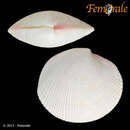fi
nimet breadcrumb-navigoinnissa


Codakia orbicularis , or the tiger lucine,[1] is a species of bivalve mollusc in the family Lucinidae. It can be found along the Atlantic coast of North America, ranging from Florida to the West Indies.[2]
Codakia orbicularis grows to maximum length of about 85 mm (3.3 in). The shell valves are nearly circular, the outer surface being sculptured with fine concentric rings and closely-packed radial lines. The lunule, a depressed area near the hinge, is heart-shaped, with the right valve lunule being larger than the left. The periostracum, a thin outside layer, is brown and the valves are mainly white; there is often a pinkish tinge near the interior margin. The shell is more laterally compressed than the smaller dwarf tiger lucine (Ctena orbiculata).[3] Like other members of its family Lucinidae, Codakia orbicularis does not have an inhalant siphon, instead rolling its elongated foot into a mucus-lined tube and drawing water into the gill cavity through this. It does have an exhalant siphon which is formed from a highly extensible mantle flap and can be inverted and drawn back into the shell.[4] The gill cavity contains chemosymbiotic sulphur-oxidizing bacteria housed in bacteriocytes which contribute to the clam's nutritional requirements.[5][6]
Codakia orbicularis is native to the western Atlantic Ocean where its range includes from Florida and the northern coast of the Caribbean Sea. It lives immersed in soft sediment on the seabed, typically in Thalassia testudinum seagrass beds. Its maximum depth is 93 m (305 ft).[1] The bacterial symbionts enable these burrowing bivalves to colonise sulfide-rich sediments with low oxygen levels that are unsuited to many other bivalves.[7]
Codakia orbicularis is a large edible shellfish and its life cycle has been studied to see whether it is suitable for mariculture. In the Bahamas, spawning takes place between May and October. The large-yolked eggs are enclosed in a thick gelatinous membrane and the early developmental stages take place inside this capsule. The later stages of the veliger larva are planktonic and metamorphosis occurs about 16 days after fertilisation. During their growth and development, the larvae may obtain nutrition from the symbiotic chemosynthetic bacteria present in their tissues.[8]
Codakia orbicularis , or the tiger lucine, is a species of bivalve mollusc in the family Lucinidae. It can be found along the Atlantic coast of North America, ranging from Florida to the West Indies.
La almeja blanca (Codakia orbicularis), es una almeja originalmente descrita como Lucina orbicularis, que pertenece a la familia Lucinidae1.
Tiene la concha de color rosado y de forma orbicular. El tamaño de los organismos adultos oscila entre 6 y 8 cm de largo. Las conchas están ornamentadas con numerosas costillas radiales, estrechas y cruzadas por elevadas líneas de crecimiento, dando una apariencia cuadriculada o reticular. Lúnula pequeña en forma de corazón. Charnela con dientes grandes y sólidos. Interior de la concha blanco o rosado, en ocasiones con una franja de color rosa en el borde de la valva. Línea paleal simple, con dos impresiones musculares, sin seno paleal2. Esta especie realiza endosimbiosis con bacterias en sus filamentos branquiales3. Codakia orbicularis es un bivalvo dioico, es decir, aquella en la que hay individuos machos e individuos hembras. Poseen una larva velígera y la metamorfosis ocurre aproximadamente 16 días después de la fertilización. El desarrollo de la larva se puede describir como lecitotrófico4.
La especie se distribuye desde Carolina del Norte a Florida, Golfo de México desde Texas hasta Yucatán, Costa Rica, Brasil2. En las Antillas es encontrada en aglomeraciones densas3.
Vive en aguas someras con fondos de arena o lodo con pastos marinos4.
Hasta el momento en México no se encuentra en ninguna categoría de protección, ni en la Lista Roja de la IUCN (International Union for Conservation of Nature) ni en CITES (Convención sobre el Comercio Internacional de Especies Amenazadas de Fauna y Flora Silvestres).
La almeja blanca (Codakia orbicularis), es una almeja originalmente descrita como Lucina orbicularis, que pertenece a la familia Lucinidae1.
Codakia orbicularis is een tweekleppigensoort uit de familie van de Lucinidae.[1] De wetenschappelijke naam van de soort is voor het eerst geldig gepubliceerd in 1758 door Linnaeus.
Bronnen, noten en/of referentiesCodakia orbicularis là một loài thân mềm hai mảnh vỏ trong họ Lucinidae. Nó có thể được tìm thấy dọc theo bờ biển Đại Tây Dương của Bắc Mỹ, phạm vi từ Florida tới West Indies.[1]
Codakia orbicularis là một loài thân mềm hai mảnh vỏ trong họ Lucinidae. Nó có thể được tìm thấy dọc theo bờ biển Đại Tây Dương của Bắc Mỹ, phạm vi từ Florida tới West Indies.